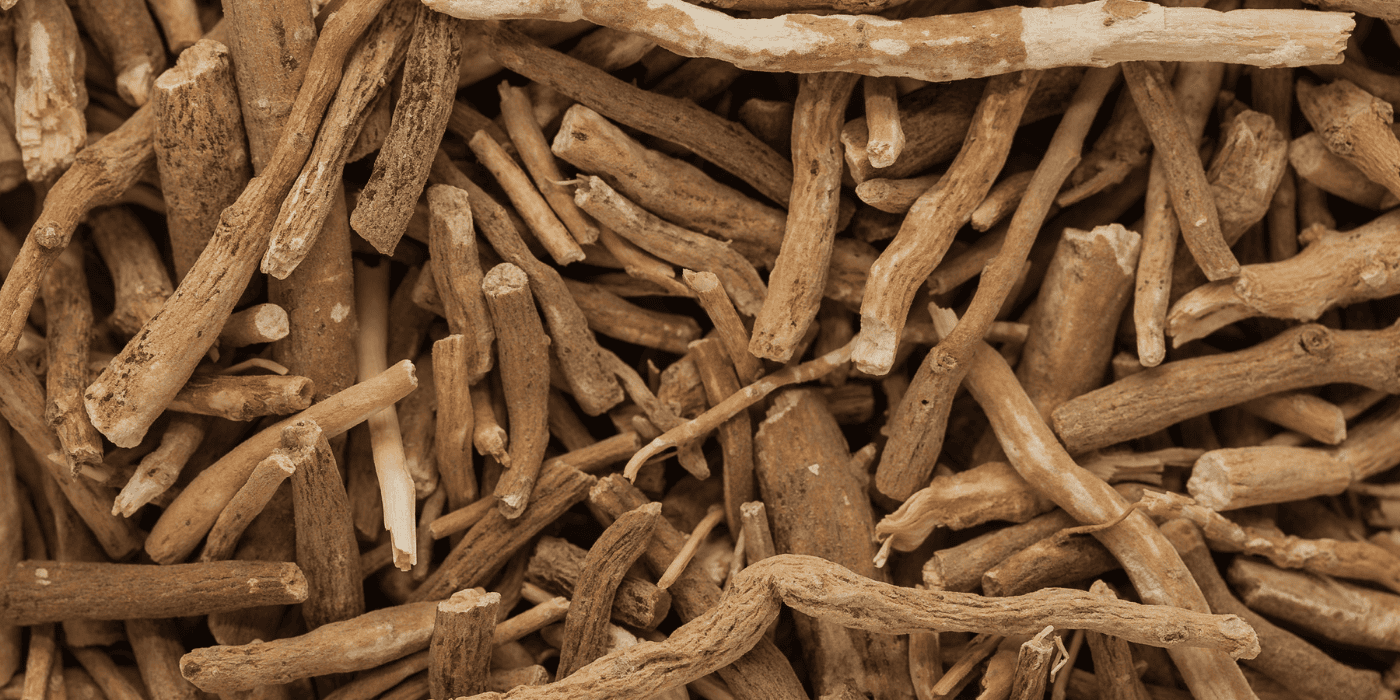Free shipping from 39 € (DE)
30-day return policy
Customer service from experts
4.9 Trustpilot rating
Free shipping from 39 € (DE)
30-day return policy
Customer service from experts
4.9 Trustpilot rating
APPLICATIONS
What's behind Ashwagandha? The Indian berry of Ayurveda
7 min read
Ashwagandha, also known as Indian ginseng, winter cherry, or Indian ginseng, is a superfood highly valued in traditional Ayurvedic medicine for its valuable nutrients. It has adaptogenic properties, meaning it helps the body better cope with stress, and can contribute to improving sleep, mood, and energy levels. It is available as capsules, powder, tea, or tinctures.

1. Ashwagandha - What is it?
The perennial plant, scientifically known as Withania somnifera, is native primarily to the Middle East and India, but is also cultivated in Spain, China, and Africa. As a nightshade, it belongs to the same plant family as tomatoes, potatoes, and eggplants. Ashwagandha berries resemble those of physalis, but are inedible due to their alkaloid content. For medicinal purposes, the root is primarily used to produce the tonic ashwagandha.
In naturopathy, Ashwagandha is used to treat sleep disorders and as a natural sedative. The name Ashwagandha comes from Sanskrit and means "horse's scent," which refers to the root's characteristic fragrance.
Traditionally, Ashwagandha has been cultivated primarily in tropical and subtropical climates such as India for over 3,000 years. Today, mainland Africa, Spain, Greece, and the Arabian Peninsula are also popular growing areas.
The plant was first scientifically described by Carl Linnaeus in the 18th century and was given the nickname Somnifera due to its sleep-inducing and calming effects. The plant's active ingredients, especially withanolides, are known for their adaptogenic properties, which help the body adapt to stress.
Ashwagandha is processed into various products, including powder, capsules, tablets, juice, tea, smoothies, and tinctures. Despite its diverse beneficial effects, high doses can cause side effects such as stomach upset or drowsiness. Therefore, pregnant and breastfeeding women in particular should consult a doctor before taking it.
2. What active ingredients are contained in Ashwagandha?
Ashwagandha contains a number of bioactive compounds that are primarily responsible for its health benefits. The most important of these are:
Withanolides: These are steroidal lactones responsible for the adaptogenic and anti-inflammatory properties of ashwagandha. They help the body cope with stress and also have antioxidant and immunomodulatory effects.
Alkaloids: These compounds have a calming effect and contribute to the sleep-promoting properties of Ashwagandha.
Saponins: These substances support the immune system and have antioxidant properties.
Cholin: An essential nutrient important for supporting cognitive and nerve function.
Phytosterols: These plant sterols can help lower cholesterol levels and have anti-inflammatory properties.
Vitamins and minerals: Ashwagandha contains vitamins B6, C, and folic acid, as well as minerals such as iron, calcium, magnesium, zinc, and manganese. These support the immune system, nerve function, and overall health.

3. Health benefits of Ashwagandha

Ashwagandha's stress-reducing and calming effects are particularly noteworthy, making it a popular natural remedy for insomnia. Scientific studies also suggest that ashwagandha can improve memory and concentration. Furthermore, the plant is said to have anti-inflammatory properties comparable to those of cortisol.
The alkaloids contained in Ashwagandha, such as somniferin and anaferin, are considered adaptogens. These substances help the body adapt better to physical and psychological stress, making it easier to process it. These active ingredients may also help relieve insomnia, giving Ashwagandha the nickname "sleep berry."
Another important ingredient in ashwagandha is withanolides, a group of triterpene lactones that share structural similarities with the active components of Asian ginseng (Panax ginseng). They are believed to be responsible for the pain-relieving and anti-inflammatory effects attributed to ashwagandha. The plant also contains large amounts of iron, which underscores its nutritional importance.
In addition, Ashwagandha's adaptogenic properties offer additional health benefits. The plant can strengthen the immune system by promoting the activity of immune cells and increasing the body's overall resistance. There is also evidence that Ashwagandha can enhance physical performance by improving muscle strength and endurance, making it a popular supplement for athletes. Additionally, Ashwagandha may support hormonal balance, particularly in regulating thyroid hormones and relieving menopausal symptoms.
4. Uses of Ashwagandha: How can it be taken?
Ashwagandha can be taken in a variety of ways, with dosage and consumption format varying depending on the product and individual needs. It's important to strictly adhere to the recommended dosage and follow the manufacturer's instructions, as specific dosage guidelines are often limited. Ashwagandha is available in various forms, including powder, capsules, tablets, and extracts.
Dosage recommendations:
Ashwagandha Capsules : It is recommended to take one capsule (500-700 mg) three times a day with plenty of liquid, ideally with meals.
Ashwagandha powder: The recommended amount is up to 4 grams per day. The powder can be mixed into drinks such as smoothies, water, or other liquids.
Ashwagandha extracts are obtained through alcoholic extraction of the roots. KSM-66 is a highly concentrated and standardized extract known for its well-researched efficacy.
Regardless of the dosage form chosen, it is important to drink sufficient fluids to optimally support the effect. The daily dose should not be exceeded.
The duration of use and the time until the effects of Ashwagandha are felt can vary, depending on the individual body's response and specific health goal.
Duration of use:
Short-term use: Many people start with Ashwagandha and notice the first effects after just a few weeks of regular use.
Long-term use: For sustained results, especially for chronic conditions such as stress or insomnia, use over several months is often recommended. Continuous use of approximately 2 to 3 months may be beneficial to experience the full benefits.
Onset of action:
Short-term: Some people report initial positive effects such as improved sleep quality or reduced stress after just 2 to 4 weeks.
Long-term: It may take several weeks to months to experience the more comprehensive benefits such as increased memory and concentration or comprehensive stress reduction.
5. Side effects of Ashwagandha: What should I be aware of?
Side effects of Ashwagandha:
Digestive problems: Ashwagandha is generally well tolerated, but digestive problems such as nausea or abdominal pain may occasionally occur.
Allergic reactions: In rare cases, allergic reactions or intolerances may occur. It is therefore advisable to start with a low dosage to detect possible allergies or intolerances early.
Instructions for use:
Pregnancy and breastfeeding: Ashwagandha should not be taken during pregnancy or breastfeeding, as there are no sufficient studies on its safety.
Pre-existing conditions: If you have existing conditions such as diabetes, high blood pressure, thyroid dysfunction, mental disorders, autoimmune diseases or intolerances, it is important to consult a doctor before taking Ashwagandha.
Product quality: To avoid risks from heavy metals, insecticides, and contaminants, pay attention to organic quality and laboratory testing from trusted manufacturers.
6. Frequently asked questions about Ashwagandha
Is Ashwagandha also suitable for women?
Ashwagandha is suitable for women and may offer benefits such as stress reduction and improved sleep quality. However, pregnant and breastfeeding women should avoid taking it, as there are no adequate safety studies.
Can you take Ashwagandha with the pill?
Ashwagandha can usually be taken with birth control pills, as there are no known interactions. However, it's advisable to discuss this with a doctor.
Can you take Ashwagandha and chasteberry together?
Ashwagandha and chasteberry can be taken together to support stress and hormonal imbalances.
What effect does Ashwagandha have on cortisol?
Ashwagandha can help lower cortisol levels and reduce stress by regulating the body's response to stress and stabilizing stress hormones.
Ashwagandha capsules or powder?
Both capsules and powder are effective dietary supplements. Capsules offer convenient dosing and standardized manufacturing quality, while powder can be flexibly mixed into beverages or foods. The choice depends on personal preference.
Does Ashwagandha cause liver damage?
Ashwagandha is not known to cause liver damage at normal dosage. However, to avoid risks, attention should be paid to quality and dosage.
Is Ashwagandha dangerous for people with cardiac arrhythmia?
People with cardiac arrhythmias should only take Ashwagandha after consulting a doctor to avoid possible interactions or side effects.
When is the best time to take Ashwagandha?
The best time to take Ashwagandha depends on the desired effect: in the morning for energy or in the evening for better sleep quality.
What are the benefits of taking Ashwagandha?
The plant is primarily valued for its calming and stress-reducing properties, as well as for its potential to enhance memory and concentration. Ashwagandha is also believed to have pain-relieving and anti-inflammatory effects. Furthermore, it may enhance physical performance, strengthen the immune system, and help regulate hormonal balance.
Ashwagandha root or berries? How can the different parts of the plant be used?
In Ayurvedic herbal medicine, only the roots and leaves are used. Both are used in dietary supplements, teas, juices, smoothies, tinctures, and other recipes.
Ashwagandha seeds and berries are toxic in large quantities. Therefore, only the root powder, root extract, or leaf extract are used. Capsules or tablets are administered with precise dosages, making them particularly easy to take.
Which other medicinal plants are compatible with Ashwagandha?
Brahmi, known as the "plant of wisdom," is also very popular in Ayurvedic medicine. Like Ashwagandha, it is used to promote concentration and enhance memory through its invigorating effect on brain cells. This is one of the reasons why it has been used as an adaptogen in meditation for centuries in Indian culture.
Another alternative to Ashwagandha is the cruciferous plant Maca. It contains a wide range of plant compounds, including various antioxidants, essential amino acids, omega-3 fatty acids, and proteins. Its antioxidant properties and positive influence on malondialdehyde and acetylcholinesterase levels lead, among other things, to strengthening memory and learning ability. Lepidium Meyenii, as it is scientifically known, is also known for its ability to promote physical performance and is therefore very popular among athletes.
7. Conclusion
Ashwagandha (Withania somnifera) is a versatile herb native to the Middle East and India, known for its stress-reducing and calming properties. Its main active ingredients, such as withanolides, alkaloids, and saponins, support stress management, sleep quality, and cognitive function. Ashwagandha is available in various forms, including capsules, powder, and extracts, and can be taken as needed. Although generally well-tolerated, pregnant women and people with pre-existing medical conditions should consult a physician before taking it. The root is the main ingredient in dietary supplements, as the berries and seeds are toxic.
References:
- Mishra LC, Singh BB, Dagenais S. Scientific basis for the therapeutic use of Withania somnifera (ashwagandha): a review. Altern Med Rev 2000;5(4):334-346.
- Singh N, Bhalla M, de Jager P, Gilca M. An overview on ashwagandha: a Rasayana (rejuvenator) of Ayurveda. Afr J Tradit Complement Altern Med. 2011;8(5 Suppl):208-213. doi:10.4314/ajtcam.v8i5S.9
- Zahiruddin S, Basist P, Parveen A, et al. Ashwagandha in brain disorders: A review of recent developments. J Ethnopharmacol. 2020;257:112876. doi:10.1016/j.jep.2020.112876
Leave a comment
Comments will be approved before showing up.

















